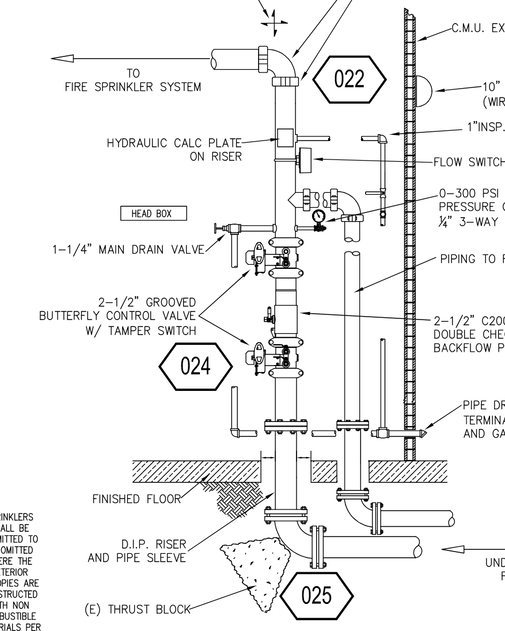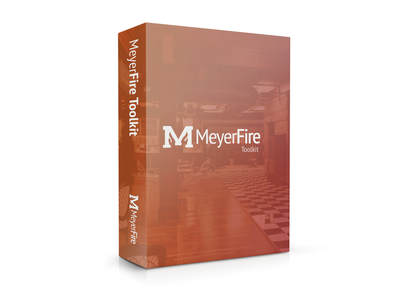|
Would you require a pressure gauge on the bottom side of the backflow device? NFPA 13 says pressure gauges shall be installed above and below each “alarm” check valve or “system riser” check valve where such devices are present. Is the backflow preventer considered an alarm check or riser check valve? Sent in anonymously for discussion. Click Title to View | Submit Your Question | Subscribe
11 Comments
Pete H
1/3/2024 07:25:24 am
I could be entirely wrong, so take with a grain of salt:
Reply
Dan Wilder
1/3/2024 07:44:05 am
All references are to NFPA 13 - 2019
Reply
Anthony
1/3/2024 07:51:37 am
A backflow preventer is definitely not considered an alarm check as it has no flow switch, alarm bell etc. I think the point of the code is to make sure the contractor actually installs the gauges in the ports provided by the alarm/riser check. I can see those getting skipped. I can see why it would be useful to have a gauge on the upstream side of the backflow preventer, but I would not require it as a specifying engineer.
Reply
Alex
1/3/2024 08:54:06 am
I do not believe a gauge is required. If there is an issue with the DCVA, it will be noticed during your forward flow test. Curious what others have to say.
Reply
sean
1/3/2024 09:03:47 am
The backflow device is not regulated by NFPA 13. If you see backflow protection is dictated by the local plumbing code. Your local plumbing code will dictate where gauges are required. If you use the International Plumbing Code 608.17.4.1 says you need a RP , RPZ, or RPDA device as a fire department connection is a second non-potable source.
Reply
Jack G
1/3/2024 10:04:57 am
To cover your bases( as AHJ ) may require, I ve been ordering the bfp with ports on each side of supply side gr valve. No difference in price, or replace the supply side with one that has the ports, or an os&y with ports. Easy gauge ports.
Reply
Casey Milhorn
1/3/2024 11:01:57 am
Lots of great comments. Some different viewpoints I hadn't considered.
Reply
Glenn Berger
1/3/2024 07:15:18 pm
I do require pressure gauges on both sides of backflow preventors.
Reply
Dave
1/4/2024 11:22:53 am
Glenn, our specs require them too (yet it is never followed), but I was drawing a blank where it originated from.
Reply
Glenn Berger
1/4/2024 02:19:34 pm
Dave,
Dwight Havens
1/6/2024 08:37:23 am
Another benefit to having a gauge on the supply side of the backflow prevention assembly (BFPA) is that it assures the ability to watch the supply side water pressure during main drain tests. I've seen a lot of confusion on which pressures to observe and record for this purpose, with many tests performed without ever relieving the pressure on the system side of the BFPA, especially on large systems. These results are then worthless in determining any change in the status of of the water supply.
Reply
Leave a Reply. |
ALL-ACCESSSUBSCRIBESubscribe and learn something new each day:
COMMUNITYTop June '24 Contributors
YOUR POSTPE EXAMGet 100 Days of Free Sample Questions right to you!
FILTERS
All
ARCHIVES
July 2024
PE PREP SERIES |
MeyerFire
- Blog
- Forum
-
THE TOOLKIT
- SUBMIT AN IDEA
- BACKFLOW DATABASE*
- CLEAN AGENT ESTIMATOR*
- CLOUD CEILING CALCULATOR
- DOMESTIC DEMAND*
- FIRE FLOW CALCULATOR*
- FIRE PUMP ANALYZER*
- FIRE PUMP DATABASE*
- FRICTION LOSS CALCULATOR
- HANGER SPACER*
- IBC TRANSLATOR*
- K-FACTOR SELECTOR*
- NFPA 13 EDITION TRANSLATOR ('19 ONLY)
- NFPA 13 EDITION TRANSLATOR ('99-'22)*
- LIQUIDS ANALYZER*
- OBSTRUCTION CALCULATOR
- OBSTRUCTIONS AGAINST WALL*
- PITOT CONVERTER
- PLUMBING FIXTURE COUNTS
- QUICK RESPONSE AREA REDUCTION
- REMOTE AREA ANALYZER*
- SPRINKLER DATABASE*
- SPRINKLER FLOW*
- SYSTEM ESTIMATOR*
- TEST & DRAIN CALCULATOR
- THRUST BLOCK CALCULATOR
- TRAPEZE CALCULATOR
- UNIT CONVERTER
- VOLUME & COMPRESSOR CALCULATOR
- WATER STORAGE*
- WATER SUPPLY (US)
- WATER SUPPLY (METRIC)
- UNIVERSITY
- PE Exam
- LOGIN
- PRICING
- OUR CAUSE

MeyerFire.com is a startup community built to help fire protection professionals shine.
Our goal is to improve fire protection practices worldwide. We promote the industry by creating helpful tools and resources, and by bringing together industry professionals to share their expertise.
MeyerFire, LLC is a NICET Recognized Training Provider and International Code Council Preferred Education Provider.
All text, images, and media Copyright © 2016-2024 MeyerFire, LLC
We respect your privacy and personal data. See our Privacy Policy and Terms of Service. The views, opinions, and information found on this site represent solely the author and do not represent the opinions of any other party, nor does the presented material assume responsibility for its use. Fire protection and life safety systems constitute a critical component for public health and safety and you should consult with a licensed professional for proper design and code adherence.
Discussions are solely for the purpose of peer review and the exchange of ideas. All comments are reviewed. Comments which do not contribute, are not relevant, are spam, or are disrespectful in nature may be removed. Information presented and opinions expressed should not be relied upon as a replacement for consulting services. Some (not all) outbound links on this website, such as Amazon links, are affiliate-based where we receive a small commission for orders placed elsewhere.














 RSS Feed
RSS Feed
